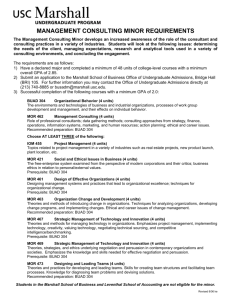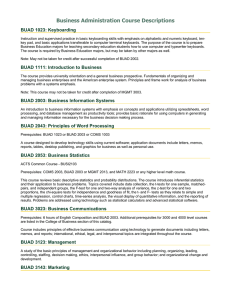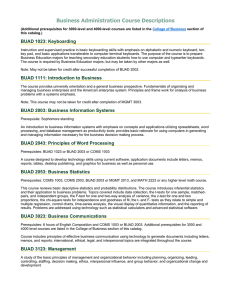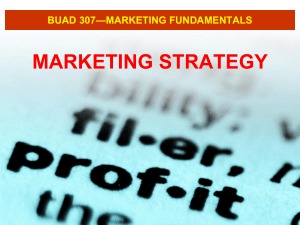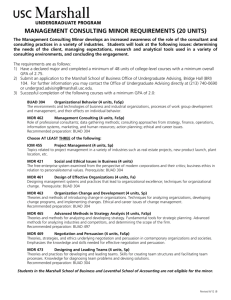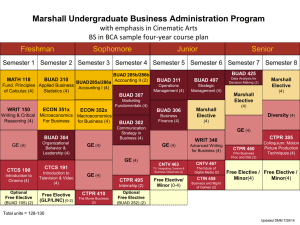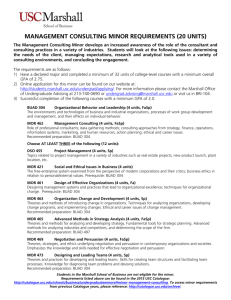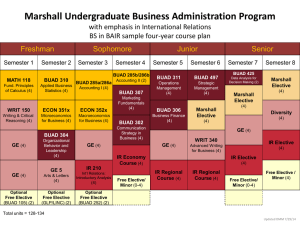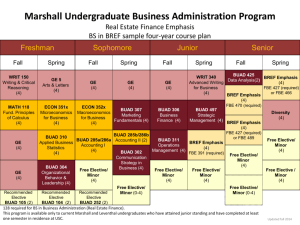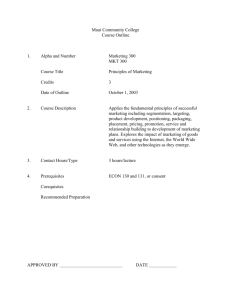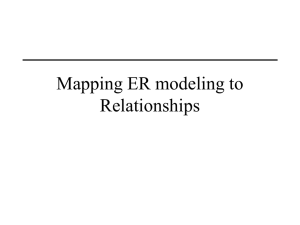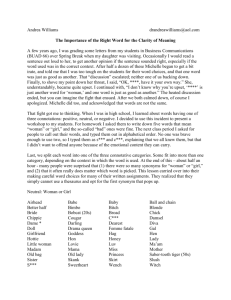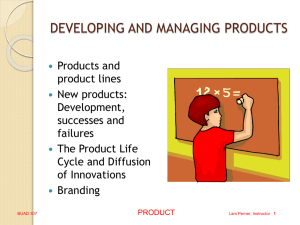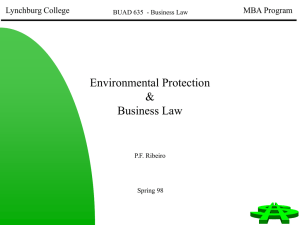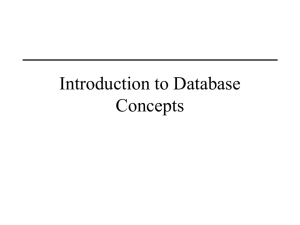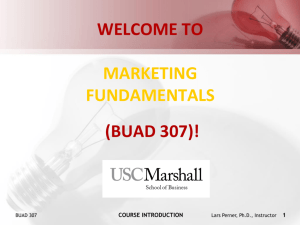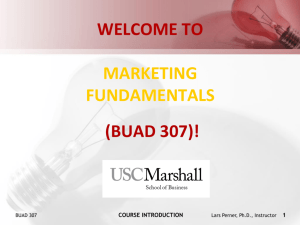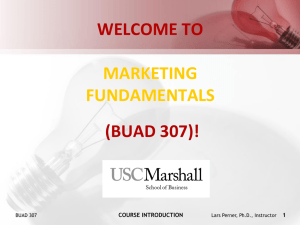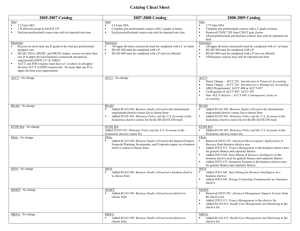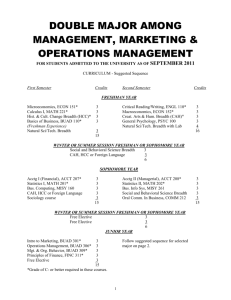Marketing Project
advertisement
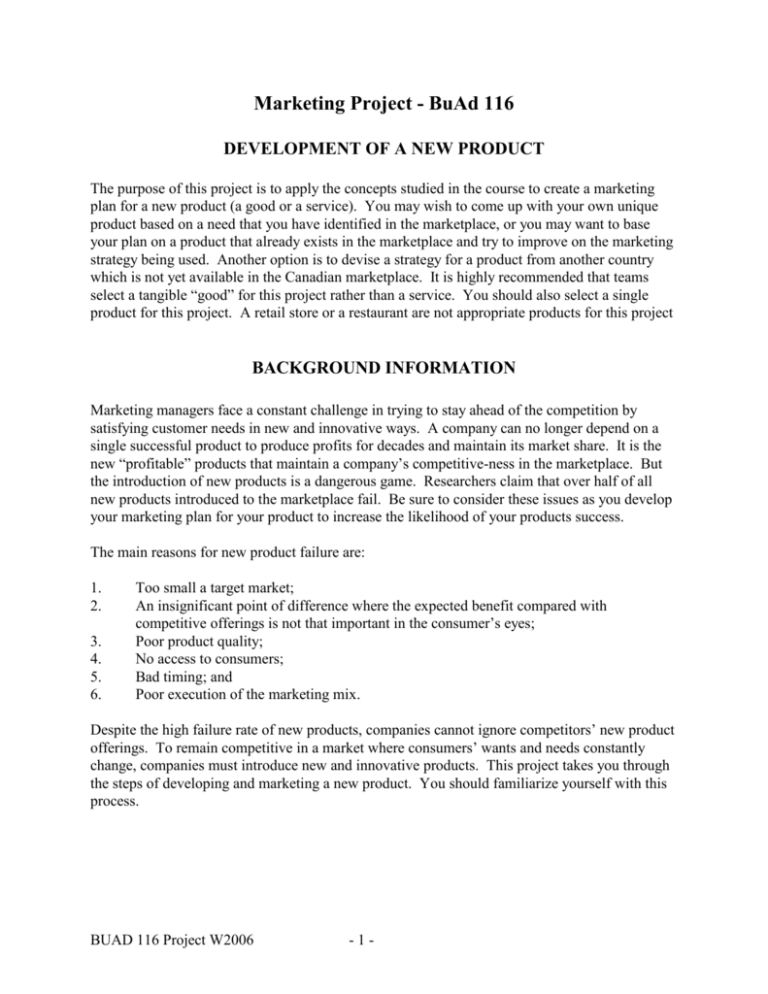
Marketing Project - BuAd 116 DEVELOPMENT OF A NEW PRODUCT The purpose of this project is to apply the concepts studied in the course to create a marketing plan for a new product (a good or a service). You may wish to come up with your own unique product based on a need that you have identified in the marketplace, or you may want to base your plan on a product that already exists in the marketplace and try to improve on the marketing strategy being used. Another option is to devise a strategy for a product from another country which is not yet available in the Canadian marketplace. It is highly recommended that teams select a tangible “good” for this project rather than a service. You should also select a single product for this project. A retail store or a restaurant are not appropriate products for this project BACKGROUND INFORMATION Marketing managers face a constant challenge in trying to stay ahead of the competition by satisfying customer needs in new and innovative ways. A company can no longer depend on a single successful product to produce profits for decades and maintain its market share. It is the new “profitable” products that maintain a company’s competitive-ness in the marketplace. But the introduction of new products is a dangerous game. Researchers claim that over half of all new products introduced to the marketplace fail. Be sure to consider these issues as you develop your marketing plan for your product to increase the likelihood of your products success. The main reasons for new product failure are: 1. 2. 3. 4. 5. 6. Too small a target market; An insignificant point of difference where the expected benefit compared with competitive offerings is not that important in the consumer’s eyes; Poor product quality; No access to consumers; Bad timing; and Poor execution of the marketing mix. Despite the high failure rate of new products, companies cannot ignore competitors’ new product offerings. To remain competitive in a market where consumers’ wants and needs constantly change, companies must introduce new and innovative products. This project takes you through the steps of developing and marketing a new product. You should familiarize yourself with this process. BUAD 116 Project W2006 -1- Stages in the New Product Development Process 1. The Idea Any new product starts as an idea generated by some individual within or outside the company. Most companies now have new product committees and/or product development departments working on new product ideas. Product ideas may come from within an organization. A factory or office worker or someone from management may suggest a new product idea. Starbucks successful (and highly profitable) Frappuccino was an idea of one of their front line employees. Ideas may also originate from outside the company and come from an intermediary (wholesaler, retailer, or agent), a competitor, or a customer. 2. Screening More ideas are often provided than a company can afford to explore. The screening stage will sift out those ideas that are unrealistic or unprofitable for the company. Many ideas do not warrant further study and can be eliminated immediately. For those ideas remaining, the company must rank them in order of potential. 3. Business Analysis A great deal of research is done at this stage. The company must examine the following: 4. Product features - What will the product look like? A sketch of the product will be produced. The essential features, packaging, and possible brand names will be explored; The market - Will there be a demand for the product? From whom? Where are these people located? Product profitability - What price should the product sell for? How many units can be sold? Does it increase the overall profitability of the company’s current products? Does it detract from the products the company normally produces and sells?; and Marketing mix - Can the product be sold through the same channels of distribution, or must new channels be mapped out? What type of promotion should be used to inform the market of the product’s availability? Will more salespeople have to be hired to distribute the product? Product Development The idea on paper must now be converted into a physical product. A pilot model is developed to determine its physical configuration. The product will be produced from detailed specifications and, possible, after laboratory test has been carried out. BUAD 116 Project W2006 -2- 5. Test Marketing Will the product succeed once it has been introduced? The only way to find out is either to offer it to the entire market or to introduce it first in a market test area. A test market allows the company to try out distribution, advertising and pricing plans and make adjustments before the product is introduced nationally and mistakes become more costly and difficult to correct. 6. Commercialization Full-scale production and marketing programs are planned and then the product is launched. The company has control of the product up to this point. Now the product must be distributed to intermediaries, and they must wait to see if the consumer accepts their offering. Prepare your project according to the outline below. This project will be prepared and submitted in sections throughout the term. It is suggested that you DO NOT WAIT until the material is covered in class but that you start immediately to read the material and begin your research. It is important that you have a good understanding of each topic area so that your discussion of that topic in your paper is thorough and correct. Working on the project a bit at a time throughout the semester means you will be less likely to forget key concepts and you will not be faced with a monumental task at the end of the term when your energy levels are low. This is a team project (teams of six) and will be submitted in five sections. The project is worth 30% of your term mark. Each section is worth 5%. You will also be required to do an in class PowerPoint presentation of your project worth 5%. Part 1 – Introduction and Target Market (5%) – Due Oct 12 Part 2 – Product (5%) and Place (5%) – Due Nov 9 Part 3 – Promotion (5%) and Price (5%) – Due Nov 30 PowerPoint Presentation 5% - Due TBA At the completion of each section, your team is required to hand in a log of work activities. All meetings including date, time, who was there and what you did. You need to follow an accepted format. At the completion of each section, you have the opportunity to submit a confidential peer and self-evaluation. This evaluation would be of use in situations where you believe the work involved in completing a section was not shared equally among team members and you wish the grade for that stage to reflect individual levels of participation. If a peer evaluation is not submitted, it will be assumed that all team members participated equally in the preparation of the section and the grade will be allocated evenly among all team members. As you will be working with the same team members throughout the term, it is important that you choose your team members carefully. BUAD 116 Project W2006 -3- Projects will be graded as follows: 70 % - Content. This includes the correct and complete use of theory and terminology discussed in class and in the text. Be certain that each section contains the required information (see page 4 – Project Outline). 20% - Grammar and Spelling 10% - Presentation. This includes title page, formatting, and professional appearance. PROJECT OUTLINE The project should be submitted in a binder. Each section should be accompanied by a title page indicating the date, the course, the instructor, and the section (introduction, product, price, place, or promotion). Please ensure that any and all graded sections are included in the binder along with the section to be graded. You are expected to keep the entire project together in the binder so that your instructor may refer back to your previous work to assess your improvement. Section 1. Introduction (Evaluating the Marketing Environment) and Target Market Your first step is to decide on a product (a good or a service) to be developed. As a team, you will need to generate ideas for new products and screen those ideas. Theoretically, a marketer would first identify a market that has needs and then design a product to fill those needs. In your project you will discuss the need that your product will satisfy, describe how you segmented the market, and identify and justify your target market selection. The information in Chapters 3, 5, and 9 will assist you in preparing this section. Once you have a good understanding of who you are going to sell to, coordinating the rest of the marketing strategy (price, place, and promotion) becomes a lot easier. It is important as well to conduct a comprehensive analysis of the marketing environment. For this project, you will focus on opportunities and threats that exist for your industry/product in the external environment. You should consider the economic, competitive, technological, legal and socio-cultural environment. Your evaluation of the external environment will help you to select/justify target market and identify the need that your product will fulfill. Chapter 3 will be of assistance to you in preparing this part of your introduction. Information Required for Section 1 Provide a general description of the good or service you have selected for this project. What need are you attempting to satisfy? BUAD 116 Project W2006 -4- Thoroughly describe your target market(s) by using demographic, psychographic, and behavioural terminology. What segmentation variables did you use to segment your market? Why did you believe these variables were relevant for the product you selected? What criteria can be used to justify your choice of target market. Describe and justify the positioning of your product in the marketplace in view of the target market you have selected. How do you think your market will perceive your product? List and describe the threats and opportunities in the external environment (social, economic, technological, competitive and regulatory forces) that may influence your product or your target market. Section 2. The Product The information in Chapters 11 and 12 will assist you in preparing this section. Information Required for Section 2 Make adjustments and changes to your Plan according to Instructor comments raised in Section 1 Describe the core, actual and augmented product. Classify your product and explain why you classified as you did. What type of innovation is your product ? Consider the 6 reasons for new product failure . Explain why your product will be successful. Where is your product in the product life cycle? Why? Discuss the product factors (for your specific product) that will affect the rate of adoption Is your product high learning, low learning, a fashion or a fad? What impact will this have on your adoption rate? Provide a sketch(s) of your product. Label the drawing(s) thoroughly. Illustrate the brand name, brand mark, and package and explain why you believe the brand name and mark are good. Describe how product will be packaged. What benefits will your packaging provide? What functions will it fulfill? Discuss the product's significant competitive advantage (explain why your target market would be motivated to select this product over competing products, or other ways to satisfy the need that you've identified). Who are your Competitors? What do they do well? What do you do better? BUAD 116 Project W2006 -5- Section 3. Place/Distribution Strategy The information in Chapter 13 & 14 will assist you in preparing this section. Information Required for Section 3 Make adjustments and changes to your Plan according to Instructor comments raised in Section 3. Develop and describe your distribution channel (is it direct or indirect? What type of intermediaries will you employ and why?). Explain the functions that each Intermediary will perform? What degree of distribution intensity will you utilize? Why? Discuss the physical distribution of your product. How will the product be stored and transported? Section 4. Promotion Strategy The information in Chapters 15, 16 & 17 will assist you in preparing this section. Information Required for Section 4 Make adjustments and changes to your plan according to Instructor comments raised in the last Section. Outline your promotional mix. Explain why you think this mix will be effective for reaching your market(s) and communicating your product benefits. What are your communication objectives? How will you determine your promotional budget? Why? Will you be employing a push strategy as well as a pull? Explain. Discuss your advertising strategy. Explain your advertising mix. You may wish to design a sample advertisement. If you do, explain the advertisement and justify it. What kind of appeal will you use in your advertising? Why? In what media will the ad be presented? Why? Explain what your trade promotions will involve. Explain what your consumer promotions will involve. Discuss how/if you will employ public relations. What would your public relations objectives be? What role will personal selling play in your communications mix? Discuss whether or not you plan to employ direct marketing as part of your communications mix. BUAD 116 Project W2006 -6- Section 5. Pricing The information in Chapter 18 will assist you in preparing this section. Information Required for Section 5 Make adjustments and changes to your Plan according to Instructor comments raised in Section 2. Indicate the approach to pricing that you will consider to help determine an approximate price level. Identify your pricing objective. What constraints exist to limit the range of price you can charge for your product? Will your price be elastic or inelastic? Explain. Will you follow a one- or a flexible price policy? Why? What adjustments (if any) to the list or quoted price will you make? For products that currently exist and for which a price has already been established, justify the current price, or establish a new price and provide rationale for the change (be sure to consider prices of competitive products). Estimate your Variable and Fixed costs and do a rough Break Even Analysis. BUAD 116 Project W2006 -7- TEAM INFORMATION TEAM GROUP NAME: ____________________________________ Team Member #1 Name:___________________________________________ Cell/Phone #:_____________________________________ Email:___________________________________________ Team Member #2 Name:___________________________________________ Cell/Phone #:_____________________________________ Email:___________________________________________ Team Member #3 Name:___________________________________________ Cell/Phone #:_____________________________________ Email:___________________________________________ Team Member #4 Name:___________________________________________ Cell/Phone #:_____________________________________ Email:___________________________________________ Team Member #5 Name:___________________________________________ Cell/Phone #:_____________________________________ Email:___________________________________________ Team Member #6 Name:___________________________________________ Cell/Phone #:_____________________________________ Email:___________________________________________ BUAD 116 Project W2006 -8-
